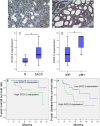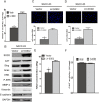SOD2 deregulation enhances migration, invasion and has poor prognosis in salivary adenoid cystic carcinoma
- PMID: 27181103
- PMCID: PMC4867643
- DOI: 10.1038/srep25918
SOD2 deregulation enhances migration, invasion and has poor prognosis in salivary adenoid cystic carcinoma
Abstract
This study aimed to investigate the role of SOD2 in the progression and metastasis of salivary adenoid cystic carcinoma (SACC). We analyzed the expression of SOD2 in 50 SACC patients. Then, the effects and mechanism of SOD2 on cell metastasis in a pair of different metastatic potential cell lines was investigated. SOD2 was deregulated in patients with SACC. Up-regulation of SOD2 was associated with distant metastasis and reduced overall survival and disease free - survival. Compared to SACC-83 cells (lower metastasis ability), SACC-LM cells (higher metastasis ability) had higher SOD2 activity and intracellular H2O2 concentrations, and protein levels of pERK1/2 and Slug, but had similar catalase protein level and activity. In SACC-LM, reducing the expression of SOD2 by SiRNA inhibited the metastasis ability and reduced the SOD2 activities, intracellular H2O2 concentrations, and protein levels of pERK1/2 and Slug. These effects were revised in SACC-83 after SOD2 overexpression. Moreover, in SACC-83, treated with H2O2, the metastasis was enhanced accompanied by increased protein levels of pERK1/2 and Slug. We confirmed that SOD2 play an important role in the development and prognosis of SACC and SOD2-dependent production of H2O2 contributes to metastasis of SACC through the ERK-Slug signaling pathway.
Figures





Similar articles
-
PRL-3 promotes migration and invasion and is associated with poor prognosis in salivary adenoid cystic carcinoma.J Oral Pathol Med. 2016 Feb;45(2):111-8. doi: 10.1111/jop.12331. Epub 2015 Jun 3. J Oral Pathol Med. 2016. PMID: 26041460 Free PMC article.
-
Expression of BTBD7 in primary salivary adenoid cystic carcinoma and correlation with Slug and prognosis.Cancer Biomark. 2016 Jun 24;17(2):179-85. doi: 10.3233/CBM-160629. Cancer Biomark. 2016. PMID: 27540976
-
MTUS1/ATIP3a down-regulation is associated with enhanced migration, invasion and poor prognosis in salivary adenoid cystic carcinoma.BMC Cancer. 2015 Mar 31;15:203. doi: 10.1186/s12885-015-1209-x. BMC Cancer. 2015. PMID: 25885343 Free PMC article.
-
[Treatment plan and prognosis of salivary adenoid cystic carcinoma with lung metastasis].Hua Xi Kou Qiang Yi Xue Za Zhi. 2019 Apr 1;37(2):214-219. doi: 10.7518/hxkq.2019.02.015. Hua Xi Kou Qiang Yi Xue Za Zhi. 2019. PMID: 31168990 Free PMC article. Chinese.
-
Manganese superoxide dismutase (Sod2) and redox-control of signaling events that drive metastasis.Anticancer Agents Med Chem. 2011 Feb;11(2):191-201. doi: 10.2174/187152011795255911. Anticancer Agents Med Chem. 2011. PMID: 21434856 Free PMC article. Review.
Cited by
-
The 8-oxoguanine DNA glycosylase-synaptotagmin 7 pathway increases extracellular vesicle release and promotes tumour metastasis during oxidative stress.J Extracell Vesicles. 2024 Sep;13(9):e12505. doi: 10.1002/jev2.12505. J Extracell Vesicles. 2024. PMID: 39235072 Free PMC article.
-
Pyruvate kinase M2 deregulation enhances the metastatic potential of tongue squamous cell carcinoma.Oncotarget. 2017 Jul 17;8(40):68252-68262. doi: 10.18632/oncotarget.19291. eCollection 2017 Sep 15. Oncotarget. 2017. PMID: 28978113 Free PMC article.
-
Immunohistochemical detection of MnSOD in colon adenocarcinoma patients - clinical application.Prz Gastroenterol. 2024;19(2):186-193. doi: 10.5114/pg.2024.139238. Epub 2024 Apr 26. Prz Gastroenterol. 2024. PMID: 38939067 Free PMC article.
-
Mitochondrial stress management: a dynamic journey.Cell Stress. 2018 Oct 8;2(10):253-274. doi: 10.15698/cst2018.10.158. Cell Stress. 2018. PMID: 31225450 Free PMC article. Review.
-
Effects of Antioxidant Gene Overexpression on Stress Resistance and Malignization In Vitro and In Vivo: A Review.Antioxidants (Basel). 2022 Nov 23;11(12):2316. doi: 10.3390/antiox11122316. Antioxidants (Basel). 2022. PMID: 36552527 Free PMC article. Review.
References
-
- Laurie S. A., Ho A. L., Fury M. G., Sherman E. & Pfister D. G. Systemic therapy in the management of metastatic or locally recurrent adenoid cystic carcinoma of the salivary glands: a systematic review. Lancet Oncol 12, 815 (2011). - PubMed
-
- He Q. et al. MicroRNA-181a suppresses salivary adenoid cystic carcinoma metastasis by targeting MAPK-Snai2 pathway. Biochim Biophys Acta 1830, 5258 (2013). - PubMed
-
- Chang B. et al. Deregulation of Bmi-1 is associated with enhanced migration, invasion and poor prognosis in salivary adenoid cystic carcinoma. Biochim Biophys Acta 1840, 3285 (2014). - PubMed
-
- Eken A. et al. Association between gene polymorphism of manganese superoxide dismutase and prostate cancer risk. J Biochem Mol Toxicol 27, 213 (2013). - PubMed
Publication types
MeSH terms
Substances
LinkOut - more resources
Full Text Sources
Other Literature Sources
Medical
Research Materials
Miscellaneous

